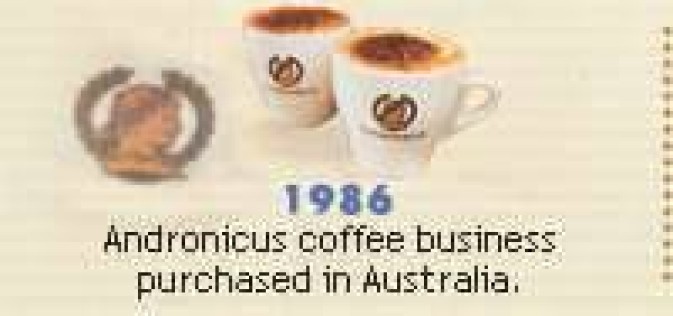Andronicus family logo.
The Andronicus Family
Becoming a cafe society
From, The New Boy Network
Ruth Ostrow
William Heinemann Australia
Richmond, Victoria
1987
Charles Andronicus makes no bones about what is at the root of his family’s success. ‘It is because of the influx of Europeans after the Second War. That is when coffee, espresso machines and cafes became popular. ‘Our growth is owed to the continental person, especially Hungarians. They brought cafe lounges to Australia after the war. They showed us how to enjoy life.’
Coffee, like so many food products, was largely neglected by the local population.
But as the Andronicus family, the Lipkies and Carlo Valmorbida soon discovered, the influx of immigrants after the Second World War helped acquaint Australians with these foreign tastes and lead to a surge in popularity in many continental, Middle Eastern and Asian foods.
Charles, 58, says that after the Second World War, the Nestle company launched Nescafe instant coffee in Australia which also ‘helped to put coffee on the map’.
The next thing the Andronjcus family knew, they were selling mass quantities of their coffee to the leading supermarkets and cafes.
Ironically Nestle, a Swiss-owned food multi-national, recently bought the trading activities (brand names) of the business from the family, in the way that many larger corporations have taken over family businesses in the past few decades.
Charles, who admits that as a young man he used to ‘open the upstairs window of the shop and throw my dad’s golfball-sized chocolates at the heads of passing tram guards’, now runs a restaurant-coffee lounge in the city with one of his children, Grant. His brother George, 55, is continuing on at the Andronicus factory as an adviser.
The Andronicus business started as a tiny shop in George Street near Circular Quay, where Charles’ father John, and John’s brothers Charles and Emmanuel, used to sell their hand-dipped chocolates and their coffee from 1910 onwards.
John came to Australia at the turn of the century. He was thirteen years old and one of eleven children. The Greek island of Kythera where he was born was barren and poor and John’s father—a fisherman—encouraged him to leave in search of a better, more affluent, life. Five of his brothers were already in Australia so he came here and, after some schooling, joined his brothers in the shop.
The business ambled along for many years, selling a variety of foods, but the Depression took its toll as did the opening of the Harbour Bridge in 1932. This meant that traffic which had previously gone down George Street was now diverted.
As a result, John bought his brothers out in 1937. While he continued the retail operations, he also did some wholesaling on a small scale, and manufactured coffee and hand-dipped chocolates.
Charles says his father John and his mother Kathleen roasted and ground coffee for retail and wholesale, at the shop, using raw coffee they had brought in from Arabia, Africa India, Brazil and New Guinea.
Then the war broke out and luxury products such as choco lates and coffee did very well, according to Charles, who together with his brother George had begun working in the business on school holidays. But he says: ‘As there was little manpower to run the business, Dad was working 14 hours a day, seven days a week. He would close the shop at 5 pm and then go out to the factory to start mixing the cream for the hand-dipped chocolate.’
In 1946 John sold the chocolates business to focus his efforts on coffee. His brother Charles then decided to open a chocolate shop and small factory to continue the sale of Andronicus hand-dipped chocolates.
John, meanwhile, started selling continental food in the premises alongside his coffee. This included olives, sesame seeds, block cheese and halva.
His son Charles used to drive around the city in his MG delivering coffee to people.
In the early 1960s his children, Charles and George, formed their own wholesale company, Andronicus Coffee Pty Ltd, while John and Kathleen continued at the shop until 1973 when it had to be closed to make way for development. (The Sydney Regent hotel now stands on the site.)
Then the boys opened a factory at Crows Nest in Sydney and from that location the wholesale and distribution business was also conducted. Later other factories were opened. Charles says:
‘We had to expand—we couldn’t leave it at that. We had to grow.’ Woolworths showed interest in the product and ‘within a year our coffee beans were in practically every Woolworths food store in the state, as well as in other supermarkets such as Franklins.’ The business grew substantially, then in 1984 Charles sold out to George who in 1986 accepted a takeover offer from Nestle.
Nestles corporate time-line:
NestleHistTimelineAUS.pdf
Charles says: ‘Dad’s ambition was to build up a company that could be enjoyed and later taken over by his sons. He created good-will and my brother and I just expanded on it. He left us a beautiful name, we were able to approach any bank for credit. My mother was his right arm.
‘His success came in that he was prepared to work hard. The old Greeks knew how to work in those days. They were taught to work hard and think hard.’
Pendergrast's The History of Coffee and How It Transformed Our World
